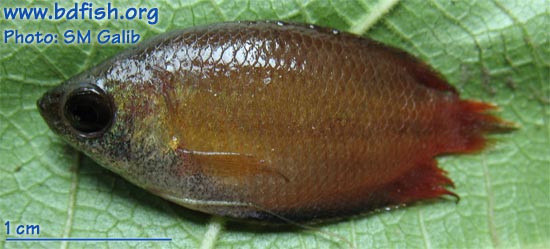
Systematic position
Phylum: Chordata
Class: Actinopterygii (Ray-finned fishes)
Order: Perciformes (Perches)
Suborder: Anabantoidei (Labyrinthici).
Family: Osphronemidae (Gouramies)
Subfamily: Luciocephalinae
Genus: Trichogaster
Species: T. chuna
Synonyms
Colisa chuna (Qureshi 1965)
Colisa sota (Hamilton, 1822)
Polyacanthus sota (Hamilton, 1822)
Trichopodus chuna Hamilton, 1822
Trichopodus sota Hamilton, 1822
Common/local names
English: Honey Gourami and Sunset gourami
Bangladesh: Chuna Khalisha (চুনা খলিশা), Khalisha (খলিশা) and Baicha (বৈচা)
India: Bahsaulee and Bainsaylee (Assam); Chunakhalisa (West Bengal) and Kholisa (Bihar) (Talwar and Jhingran, 1991).
Distributions Bangladesh and India (Gangetic provinces and Assam) (Talwar and Jhingran, 1991).
Conservation status: Not threatened in Bangladesh (IUCN Bangladesh, 2000). Drying of habitat and the use of insecticides in paddy fields are the major threat (Siddique, 2007).
Morphology: Body oblong and compressed. Small and protractile mouth present. Preorbital serrated. Dorsal spine posteriorly increasing. Caudal fin slightly emarginated. Dorsal soft and pointed. A filiform ray present at the pelvics which is extended to the caudal. Lateral line incomplete, interrupted and sometimes absent. 27-28 (Rahman, 1989 and 2005); 27-29 (Talwar and Jhingran, 1991) scales in lateral series.
Body color dull greenish above and brownish below. A distinct dark band extends from the eye to the caudal.
Fin formula:
D. XVI-XVIII/6-8; P1. 8-9; P2. 1; A. XX-XXIII/12-13; C. 15 (Rahman, 1989 and 2005; Siddique, 2007)
D XVII-XVIII 6-9; A XVIII-XXII 11-13; P 9 (Talwar and Jhingran, 1991)
D. XVII-XVIII/7-8; P. 9-10; A. XVII-XX/11-15 (Shafi and Quddus, 2001)
Maximum lengths: 4.2 cm (Rahman, 1989 and 2005), 4.5 cm (Shafi and Quddus, 2001) and 7cm (Siddique, 2007),
Habitats: Freshwaters of Bangladesh; Pools, ditches, inundated fields, ponds and beels are its major habitat (Rahman, 2005). Benthopelagic (Siddique, 2007). Abundantly found in inundated rice and jute fields during rainy season (Shafi and Quddus, 2001).
Parental care: They make bubble nest and male fish guards it during breeding period (Siddique, 2007).
Food and feeding habit: Omnivorous, feed on plankton, vegetation and detritus (Siddique, 2007)
Fishery info: Of no interest to fisheries (Talwar and Jhingran, 1991). Used as food fish in Bangladesh.
__________________________________________________________
REFERENCES
Hamilton F (1822) An account of the fishes found in the river Ganges and its branches. Edinburgh & London. An account of the fishes found in the river Ganges and its branches.: i-vii + 1-405, Pls. 1-39.
IUCN Bangladesh (2000) Red book of threatened fishes of Bangladesh, IUCN- The world conservation union. xii+116 pp.
Rahman AKA (1989) Freshwater Fishes of Bangladesh, 1st edition, Zoological Society of Bangladesh, Department of Zoology, University of Dhaka, Dhaka-1000, pp. 279-280.
Rahman AKA (2005) Freshwater Fishes of Bangladesh, 2nd edition, Zoological Society of Bangladesh, Department of Zoology, University of Dhaka, Dhaka-1000, pp. 304-305.
Shafi M and Quddus MMA (2001) Bangladesher Matsho Shampad (Fisheries of Bangladesh) (in Bengali), Kabir publication. Dhaka, Bangladesh. pp. 304-305.
Siddique KU (ed.) (2007) Encyclopedia of Flora and Fauna of Bangladesh Freshwater fishes Vol. 23, Asiatic Society of Bangladesh, Dhaka, Bangladesh, 300 pp.
Talwar PK and Jhingran AG (1991) Inland Fishes of India and Adjacent Countries, Vol. 2, Oxford & IBH Publishing Co. Pvt. Ltd. New Delhi-Calcutta, pp. 1007-1008.
Visited 2,392 times, 1 visits today | Have any fisheries relevant question?
